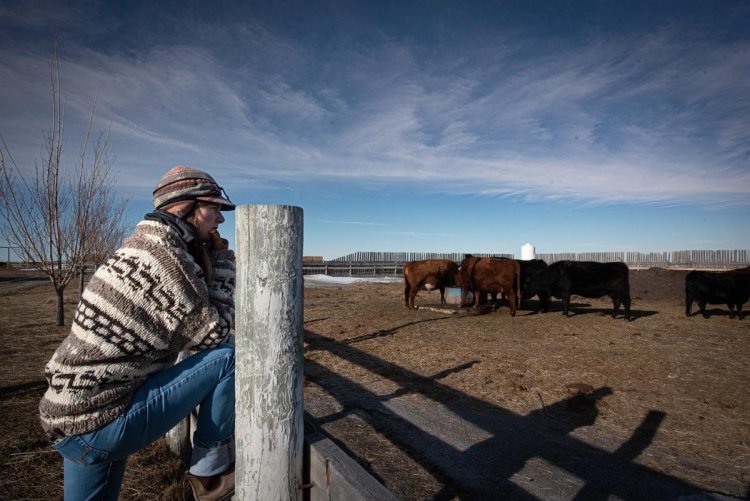Canadian farmers and ranchers are plotting for a future with less carbon — and they’re making it work
NANTON, Alta.— Rancher John Cross is blunt about what climate change predictions mean for his family. “My kids are not going to have as good a life as I have.”Cross owns A7 Ranche, a 5,260-hectare operation west of Nanton, Alta., in the foothills of the Livingstone Range. His grandfather, A.E. Cross, one of Calgary’s storied “Big Four” cattlemen who founded the Calgary Stampede, started the ranch in 1886.The Cross family has paid a lot of attention to weather over the years, but last year’s extremes introduced new terms to the local lexicon: phenomena such as “heat dome” and “atmospheric river.” Alberta saw its second year of drought, leading to crop failures and high costs of animal feed. Flooding wiped out B.C.’s Coquihalla Highway.Cross is currently training his family to take over A7. He wants to see them succeed, so he’s changing the way he works.He’s adopting methods some call regenerative — farming and grazing practices that restore degraded soil and increase carbon capture. He’ll put cattle out to graze in small pastures for about a day, then move them to another pasture and allow grazed areas to recover for several weeks. He uses electric fencing to keep cattle away from sensitive areas. Cross’s methods reflect good business savvy. Whole Foods Market listed regenerative agriculture as its number one food trend in 2020. A 2021 report from the data company Spoonshot indicated business interest in regenerative agriculture had more than doubled in just two years, with companies such as General Mills, PepsiCo and Unilever investing millions. But Cross looks sideways at the word.“You can get in an argument over tools rather than biological process. Leave the tools to the person who knows what they’re doing. Don’t talk about ‘regenerative.’ It’s termy.”Whatever you call it, healthier soil means higher yield. He’s able to graze twice as many cattle now as when he took over. Another outcome is that more atmospheric carbon is locked into plants and soil through photosynthesis, which may mean a shot at doing something about climate change.So while the techniques to improve soil may be nothing new, what is new is the way policy connections are being made between soil health and climate change mitigation.“If you add up all the arable and grazing land in Canada and move just a little bit of carbon out of the air” and into the soil, Cross says, “it looks after a lot of the emissions for Canada.” It’s a good deed for which he thinks ranchers should be compensated in the form of carbon offsets: selling sequestered carbon on the open market. Two hours north of A7, Sarah and Marcus Riedner are also digging into regenerative practices.Formerly employed in the tech sector with backgrounds in fine arts, the Calgary couple was growing increasingly disturbed by the climate crisis. Marcus had helped form the farming co-operative YYC Growers when he was still just backyard gardening.After they inherited some money, the Riedners decided to go whole hog and buy 62 hectares near Carstairs. They decided not to use fertilizers or pesticides. They seeded bare land with 12 species of plants to create pastures; even during last year’s drought the grass was waist-high and a number of birds had nested in it. They bought cattle to graze and fertilize the pastures. They planted trees and cover crops. They take pains to leave no bare soil. They’ve seen increased carrying capacity in pastures. They heard the throaty frog song, even in the driest part of the summer. In the five years they’ve been farming this way Riedner says they’ve seen the organic matter in their soil increase to 10 per cent from less than one per cent, higher than the industry standard of three to four per cent.“It’s pretty nerdy, but our soil samples make me giddy,” he says. “Our original goal when we took over the land was to get to 10 per cent organic matter by the time I was 65. That seemed like an aggressive but realistic goal. So to hit it in five years? Wow.”He says their new goal is to drive that organic matter twice as deep. Most farmers are only concerned with the top 10 centimetres or so, but he’d like that rich soil layer to be thicker and sequester that much more carbon. “I’ve got 20 years, give or take.”So why doesn’t everyone farm this way? Riedner says money is one thing. He estimates they’ve invested $1 million into shifting the land away from conventional crop farming. The other is beef’s bad rap. Increasingly people with environmental concerns are advocating for plant-based diets as a climate-change mitigation strategy. But Riedner reads the Intergovernmental Panel on Climate Change report every year, and he believes — at least on the Canadian prairies — that some kinds of cattle operations are actually part of the climate solution.“A cow on grass in a proper ecosystem is going to beat cultured meat over and over again,” Riedner says. “Vat meat requires an entire industrial complex to support it. Whereas a cow on a pasture requires a complex ecosyst


NANTON, Alta.— Rancher John Cross is blunt about what climate change predictions mean for his family. “My kids are not going to have as good a life as I have.”
Cross owns A7 Ranche, a 5,260-hectare operation west of Nanton, Alta., in the foothills of the Livingstone Range. His grandfather, A.E. Cross, one of Calgary’s storied “Big Four” cattlemen who founded the Calgary Stampede, started the ranch in 1886.
The Cross family has paid a lot of attention to weather over the years, but last year’s extremes introduced new terms to the local lexicon: phenomena such as “heat dome” and “atmospheric river.” Alberta saw its second year of drought, leading to crop failures and high costs of animal feed. Flooding wiped out B.C.’s Coquihalla Highway.
Cross is currently training his family to take over A7. He wants to see them succeed, so he’s changing the way he works.
He’s adopting methods some call regenerative — farming and grazing practices that restore degraded soil and increase carbon capture. He’ll put cattle out to graze in small pastures for about a day, then move them to another pasture and allow grazed areas to recover for several weeks. He uses electric fencing to keep cattle away from sensitive areas.
Cross’s methods reflect good business savvy. Whole Foods Market listed regenerative agriculture as its number one food trend in 2020. A 2021 report from the data company Spoonshot indicated business interest in regenerative agriculture had more than doubled in just two years, with companies such as General Mills, PepsiCo and Unilever investing millions. But Cross looks sideways at the word.
“You can get in an argument over tools rather than biological process. Leave the tools to the person who knows what they’re doing. Don’t talk about ‘regenerative.’ It’s termy.”
Whatever you call it, healthier soil means higher yield. He’s able to graze twice as many cattle now as when he took over. Another outcome is that more atmospheric carbon is locked into plants and soil through photosynthesis, which may mean a shot at doing something about climate change.
So while the techniques to improve soil may be nothing new, what is new is the way policy connections are being made between soil health and climate change mitigation.
“If you add up all the arable and grazing land in Canada and move just a little bit of carbon out of the air” and into the soil, Cross says, “it looks after a lot of the emissions for Canada.” It’s a good deed for which he thinks ranchers should be compensated in the form of carbon offsets: selling sequestered carbon on the open market.
Two hours north of A7, Sarah and Marcus Riedner are also digging into regenerative practices.
Formerly employed in the tech sector with backgrounds in fine arts, the Calgary couple was growing increasingly disturbed by the climate crisis. Marcus had helped form the farming co-operative YYC Growers when he was still just backyard gardening.
After they inherited some money, the Riedners decided to go whole hog and buy 62 hectares near Carstairs. They decided not to use fertilizers or pesticides. They seeded bare land with 12 species of plants to create pastures; even during last year’s drought the grass was waist-high and a number of birds had nested in it. They bought cattle to graze and fertilize the pastures. They planted trees and cover crops. They take pains to leave no bare soil. They’ve seen increased carrying capacity in pastures. They heard the throaty frog song, even in the driest part of the summer.
In the five years they’ve been farming this way Riedner says they’ve seen the organic matter in their soil increase to 10 per cent from less than one per cent, higher than the industry standard of three to four per cent.
“It’s pretty nerdy, but our soil samples make me giddy,” he says. “Our original goal when we took over the land was to get to 10 per cent organic matter by the time I was 65. That seemed like an aggressive but realistic goal. So to hit it in five years? Wow.”
He says their new goal is to drive that organic matter twice as deep. Most farmers are only concerned with the top 10 centimetres or so, but he’d like that rich soil layer to be thicker and sequester that much more carbon.
“I’ve got 20 years, give or take.”
So why doesn’t everyone farm this way? Riedner says money is one thing. He estimates they’ve invested $1 million into shifting the land away from conventional crop farming. The other is beef’s bad rap. Increasingly people with environmental concerns are advocating for plant-based diets as a climate-change mitigation strategy. But Riedner reads the Intergovernmental Panel on Climate Change report every year, and he believes — at least on the Canadian prairies — that some kinds of cattle operations are actually part of the climate solution.
“A cow on grass in a proper ecosystem is going to beat cultured meat over and over again,” Riedner says. “Vat meat requires an entire industrial complex to support it. Whereas a cow on a pasture requires a complex ecosystem that is also providing environmental services that are mitigating climate change.”
By his back-of-the-napkin calculations, their farm has pulled about 10,000 metric tons of carbon out of the atmosphere. Per capita carbon dioxide emissions in Canada are thought to be around 15 metric tons a year. That’s more than 600 person-years of carbon that Riedner believes he’s captured: in his mind, enough to make his unborn grandchildren carbon-neutral.
Rachel Herbert’s path to ranching was similarly unusual.
She also grew up in Calgary but spent summers on her grandparents’ ranch about a country mile from A7. Herbert, who was a vegetarian and studied literature in university, had just “fallen in love and married a cowboy.” After her grandparents died and the family land was reorganized, she and Tyler bought the ranch and created Trail’s End Beef.
“I didn’t necessarily have a grand environmental agenda,” Herbert says. “I was just a kid who really liked animals. The first meat I ate was from a steer I raised from a bottle. Eating that meat was like a sacrament.”
But what really convinced her to raise cattle and eat meat was what cattle stood to add to her land. Trail’s End produces exclusively grass-fed beef. That means her cattle eat only grass and hay from the time they’re weaned until they’re butchered, with no stops in the feed lot for fattening, where cattle would usually be fed grain. Grass and hay are perennial crops and fix more carbon in the soil than annual crops such as corn and wheat. Their manure becomes fertilizer.
“Eating plant-based is not a regenerative model,” Herbert says. “You need to be doing something to build fertility back into the soil. Eating grass-fed beef, in my mind, is what we can do to eat regeneratively.”
Herbert says in the 13 years they’ve been on the ranch, they’ve started to see improvements in the soil.
“There was a reason this land had never been farmed when we bought it,” Herbert says. “The soil is essentially crushed sandstone. The natural colour of the soil is the same colour of this concrete. But we can see the soil changing colour in some spots. There’s more humus in it. It’s a slow process, nothing happens overnight.”
So is regenerative agriculture a new innovation in agriculture, or is it just spit and polish on the traditional circular economy of the family farm — use everything at hand, waste nothing, diversify?
Keith Currie, a grains and oilseed farmer near Collingwood, Ont., and first vice-president of the Canadian Federation of Agriculture, says the problem with regenerative agriculture as a label is that it sticks to almost anything.
He says planting cover crops and using no-till seed drilling, two practices fundamental to maintaining carbon in soil and common to regenerative operations, have been widespread among crop farmers in Canada since the 1990s. But those practices need to be framed differently now.
“The two biggest sequesters of carbon are forestry and agriculture,” Currie says, “and that story’s not being told. We’d like to partner with the federal government to incentivize us to try and do more.” In February, Ottawa announced $182.7 million to help farmers lower emissions.
While Currie has his eye on government incentives, Jo-Ann McArthur sees the consumer side of things. As president of Nourish Food Marketing in Toronto, she agrees it’s difficult to nail down just what regenerative means. Consumers are generally more interested in soil and climate health, and many are willing to pay for it.
“You can sell organic food in certain categories for a higher margin,” McArthur says. “Farmers are great businesspeople. They’re great at adapting technology, but there has to be something in it for them.”
Perhaps similar to organic food labelling, consumers will one day see regenerative labelling in the supermarket. The Colorado-based non-governmental organization, Savory, has developed “Ecological Outcome Verification” branding; it lists more than 1,000 meat, dairy, wool, hemp, wine, cashmere and leather products made according to its land-use protocols.
Back in southern Alberta, the day may not be far off when John Cross might be able to sell carbon offsets for the rotational grazing work he’s doing.
Farmer’s Edge is a “digital agriculture company” in Winnipeg that acts as a carbon broker for farmers who have adopted low-carbon methods of growing with the intention of selling those credits on an open market. Founder and CEO Wade Barnes says that at the initial public offering a year ago he had “one little slide” in his presentation saying in two years they would be creating offsets for farmers. Interest skyrocketed from the start, which Barnes expects will produce nearly a million tonnes of offsets he will be able to sell later this year. Large emitters could buy those credits to show they are adhering to Canada’s target to significantly reduce greenhouse gas emissions by 2030.
And carbon market protocols for cattle ranchers are coming, he says.
There are only a handful of other companies in Canada doing the work Barnes’s does, but he chuckles when asked if he expects to see more.
“Everyone and their dog’s going to come out when this market starts to develop. Honest Abe’s Carbon Credit locations will be popping up everywhere, you wait and see.”
Which suits Keith Currie of the CFA just fine.
“Regenerative to the general public is a romantic notion. But carbon is real.”
Monica Kidd is a writer and physician and a fellow in the University of Toronto Dalla Lana Global Journalism Fellowship.




















